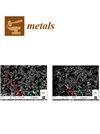碳钢和不锈钢之间异种 MIG 焊接的材料强度优化
IF 2.5
3区 材料科学
Q3 MATERIALS SCIENCE, MULTIDISCIPLINARY
引用次数: 0
摘要
本研究探讨了在 SUS 304 不锈钢和 S20C 钢上进行 MIG 焊接时,脱焊、焊接电流、焊接速度和电压对机械特性和微观结构的影响。采用田口方法使实验结果最大化。在熔合部位形成了细小的柱状树枝状晶,在熔合线和奥氏体相之间积累了具有暗线和形状的δ-铁素体相。焊接电流 110 A、电压 15 V、焊接速度 500 mm/min、伸出长度 12 mm 是极限拉伸强度(UTS)的最佳设置。确认的 UTS 值为 469.4 兆帕,与使用田口技术确定的估计值一致。拉伸试验表明,焊接电流对机械性能的影响远远大于焊接电压、速度和伸出距离。抗弯强度的理想焊接参数如下:伸出距离为 12 毫米,电弧电压为 15 伏,焊接速度为 450 毫米/分钟,焊接电流为 110 安培。Taguchi 方法是有用的,抗折强度达到了 1937.45 兆帕,远高于其他样品的抗折强度。热退火工艺对异种焊接接头机械特性的影响可能是未来研究的主题。调查结果可为异种焊接领域提供更多有价值的信息。本文章由计算机程序翻译,如有差异,请以英文原文为准。
Material Strength Optimization of Dissimilar MIG Welding between Carbon and Stainless Steels
This study examines the effects of stick-out, welding current, welding speed, and voltage on the mechanical characteristics and microstructure of MIG welding on SUS 304 stainless steel and S20C steel. The Taguchi method was used to maximize the experiment’s outcomes. Fine columnar dendrites formed at fusion sites, and δ-ferrite phases with dark lines and shapes accumulated between the fusion line and the austenite phases. A welding current of 110 A, voltage of 15 V, welding speed of 500 mm/min, and stick-out of 12 mm were the optimal settings for the ultimate tensile strength (UTS). The UTS value confirmation was 469.4 MPa, which agrees with the estimated value determined using the Taguchi technique. The tensile test revealed that welding current had a far greater impact on mechanical qualities than welding voltage, speed, and stick-out distance. The ideal welding parameters for flexural strength were as follows: stick-out of 12 mm, arc voltage of 15 V, welding speed of 450 mm/min, and welding current of 110 amp. The Taguchi method is useful, as evidenced by the validation of the flexure strength of 1937.45 MPa, which is much greater than the other samples. The impact of the thermal annealing process on the mechanical characteristics of the dissimilar weld joints could be the subject of future research. The investigation results may offer more insightful information about the dissimilar welding field.
求助全文
通过发布文献求助,成功后即可免费获取论文全文。
去求助
来源期刊

Metals
MATERIALS SCIENCE, MULTIDISCIPLINARY-METALLURGY & METALLURGICAL ENGINEERING
CiteScore
4.90
自引率
13.80%
发文量
1832
审稿时长
1.5 months
期刊介绍:
Metals (ISSN 2075-4701) is an open access journal of related scientific research and technology development. It publishes reviews, regular research papers (articles) and short communications. Our aim is to encourage scientists to publish their experimental and theoretical results in as much detail as possible. Therefore, there is no restriction on the length of the papers. The full experimental details must be provided so that the results can be reproduced. Metals provides a forum for publishing papers which advance the in-depth understanding of the relationship between the structure, the properties or the functions of all kinds of metals.
 求助内容:
求助内容: 应助结果提醒方式:
应助结果提醒方式:


